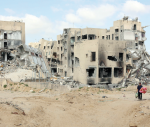You are here
Promising signs appear and disappear
Nov 03,2015 - Last updated at Nov 03,2015
Every time we see promising signs for an end to the Syrian crisis, adverse indications soon after point in the opposite direction.
Despite news of understandings among influential powers that hold the key to solving the Syrian problem, meetings in European capitals and perpetual movement of high-level Arab officials, the war continues unabated, the destruction continues to destroy cities and towns and the death toll remains on the rise. The crisis grinds on.
The Vienna meeting last week did end with a constructive agenda for a political settlement.
The final statement of the meeting, which was attended by Iran — certainly an important development — but not Syria, did emphasise significant principles that reflect a balanced outcome that took the concerns of most parties into consideration.
The reason I include below the full text of the nine said principles in this short article is that I want to comment on some of them. Here they are:
1. Syria’s unity, independence, territorial integrity and secular character are fundamental.
2. State institutions will remain intact.
3. The rights of all Syrians, regardless of ethnicity or religious denomination, must be protected.
4. It is imperative to accelerate all diplomatic efforts to end the war.
5. Humanitarian access will be ensured throughout the territory of Syria, and the participants will increase support for internally displaced persons, refugees and their host countries.
6. Daesh, and other terrorist groups, as designated by the UN Security Council, and further, as agreed by the participants, must be defeated.
7. Pursuant to the 2012 Geneva Communiqué and UN Security Council Resolution 2118, the participants invited the UN to convene representatives of the government of Syria and the Syrian opposition for a political process leading to credible, inclusive, non-sectarian governance, followed by a new constitution and elections.
These elections must be administered under UN supervision to the satisfaction of the governance and to the highest international standards of transparency and accountability, free and fair, with all Syrians, including the diaspora, eligible to participate.
8. This political process will be Syrian led and Syrian owned, and the Syrian people will decide the future of Syria.
9. The participants, together with the United Nations, will explore modalities for, and implementation of, a nationwide ceasefire to be initiated on a date certain and in parallel with this renewed political process.
The importance of the first three principles reflects a growing consensus that the Syrian state should not be allowed to disintegrate the way Iraq did.
That is the lesson the nations that out of sheer recklessness decided to invade Iraq at the beginning of this century, and the so-called international community that supported them, have learned from that costly political adventure, and the resulting chaos the Middle East continues to struggle to cope with.
Let us hope this lesson remains as a guiding factor for clearing the prevailing regional mess.
Principle 4 of the Vienna conclusion sounds vague, non-committal and even dubious. Who is meant “to accelerate all diplomatic efforts to end the war” if those important leaders who went to Vienna with the sole purpose of approving a plan to put an end to the five-year war did not?
If the Vienna gathering was to live to its promise, it should have decided to recommend, if not order, an immediate ceasefire, rather than urge future diplomatic efforts towards that end.
The negative implication that can hardly be missed here is that the participants failed to address the most basic prerequisite for marking the beginning of the end of the Syrian war.
How can any of the other components of the political settlement plan be implemented if the war does not stop?
There is however some elaboration on item 4 in principle 9, which calls for the exploration of the modalities of a nationwide ceasefire, but that call also remains within the realm of highly uncertain future prospects.
The importance of item 6 of the Vienna meeting cannot be overlooked either. It calls for the defeat of all terrorists fighting in Syria, whether as designated by the UN Security Council or as agreed by the participants.
This has been a Syrian demand all along. Most likely, therefore, attending Syrian allies, Russia and Iran, must have pushed this formulation.
The grey area, however, remains problematic: while for the Syrian government everyone carrying arms against the regime is a terrorist, the Assad regime opponents insist on separating “moderate opposition” and other groups as legitimate parties in the conflict that should be part of the political future of the country rather than be defeated.
All the remaining Vienna statement provisions seem to be positive. But in its totality, the declaration does not offer a blueprint for a solution.
A step forward, a step in the right direction it may be, but bearing in mind the seriousness of the crisis, it is far from adequate.
The stumbling block once more was the future of President Bashar Assad.
On that point there was no agreement, with Syrian allies insisting that such a matter should only be settled within the Syrian house, while others, far too committed to his removal, stood their ground: he has no place in any future accommodation.
Paragraph 8 of the communiqué clearly states that the “political process will be Syrian led and Syrian owned”, which could be interpreted in a way that leaves ample room for an elected president serving his legitimate term, in the said political process, even if for a limited phase.
But what eventually counts is how the players interpret the text.
So far, we have to remain patient before expecting any spectacular change.














